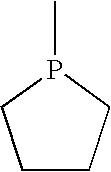Preparation of polyisocyanates of the trimer type
a trimer type, polyisocyanate technology, applied in the direction of organic-compound/hydride/coordination-complex catalysts, physical/chemical process catalysts, chemical instruments and processes, etc., can solve the problems of unrecoverable, unwanted follow-on reactions, and hampered prior-art catalysts for the preparation of trimer type polyisocyanates, etc., to achieve high monomer conversion, low average nco functionality, and limited suitability
- Summary
- Abstract
- Description
- Claims
- Application Information
AI Technical Summary
Benefits of technology
Problems solved by technology
Method used
Image
Examples
example 1
Catalyst: 1-methylphospholane, I
[0074]20 g (0.12 mol) of freshly distilled HDI (Bayer MaterialScience, 51368 Leverkusen, DE) were stirred at 60° C. first under reduced pressure (0.1 mbar) in order to remove dissolved gases for 1 h, then blanketed with dry nitrogen and admixed at 30° C. with 0.16 g (1.5 mmol) of 1-methylphospholane. The rise in the refractive index, as a measure of the progressing reaction, was monitored (Table 2).
TABLE 2Reaction timehh:mmnD2000:001.452302:401.457604:351.460019:301.477743:001.4970
[0075]After 43 hours the reaction was “stopped” by addition of 55 mg (1.7 mmol) of elemental sulphur, and the virtually colourless product mixture obtained was then analysed; cf. Table 3.
TABLE 3Iso-Iminooxa-UretoniminesUretdionescyanuratesdiazinedionesEx.nD20[mol %][mol %][mol %][mol %]11.49700.59.562.827.2
example 2
Catalyst: 1-butylphospholane, II
[0076]In a double-walled vessel with flat-ground joints, heated at 30° C. by means of an external circuit, having a stirrer, attached to an inert gas unit (nitrogen / vacuum), reflux condenser and thermometer, 600 ml of HDI were introduced and degassed. After nitrogen blanketing, 1.48 g (10 mmol) of catalyst II were added and the mixture was stirred at 30° C. for the time indicated in Tab. 4. In order to rule out contamination of the reaction mixture with atmospheric oxygen, no sampling was carried out, and distillative work-up took place after a reaction time of approximately 7 hours, without deactivation of the catalyst beforehand. Working up took place by a vacuum distillation in a thin-film evaporator, short-path evaporator (SPE) type, with upstream pre-evaporator (PE) (distillation data: pressure: 0.08 mbar, PE temperature: 120° C., ME temp.: 140° C., distillation time: approximately 1 h), with unreacted monomer being separated together with the ac...
example 3
Catalyst: butylphobane, isomer mixture III
[0078]In a double-walled vessel with flat-ground joints, heated at 40° C. by means of an external circuit, having a stirrer, attached to an inert gas unit (nitrogen / vacuum), reflux condenser and thermometer, 500 ml of HDI were introduced and degassed. After nitrogen blanketing, 0.59 g (3 mmol) of catalyst III was added and the mixture was stirred at 40° C. for the time indicated in Tab. 5. In order to rule out contamination of the reaction mixture with atmospheric oxygen, no sampling was carried out, and distillative work-up took place after a reaction time of approximately 15 hours, without deactivation of the catalyst beforehand. Working up took place by a vacuum distillation in a thin-film evaporator, short-path evaporator (SPE) type, with upstream pre-evaporator (PE) (distillation data: pressure: 0.08 mbar, PE temperature: 140° C., ME temp.: 150° C., distillation time: approximately 1 h), with unreacted monomer being separated together w...
PUM
| Property | Measurement | Unit |
|---|---|---|
| temperature | aaaaa | aaaaa |
| temperature | aaaaa | aaaaa |
| temperature | aaaaa | aaaaa |
Abstract
Description
Claims
Application Information
 Login to View More
Login to View More - R&D
- Intellectual Property
- Life Sciences
- Materials
- Tech Scout
- Unparalleled Data Quality
- Higher Quality Content
- 60% Fewer Hallucinations
Browse by: Latest US Patents, China's latest patents, Technical Efficacy Thesaurus, Application Domain, Technology Topic, Popular Technical Reports.
© 2025 PatSnap. All rights reserved.Legal|Privacy policy|Modern Slavery Act Transparency Statement|Sitemap|About US| Contact US: help@patsnap.com



